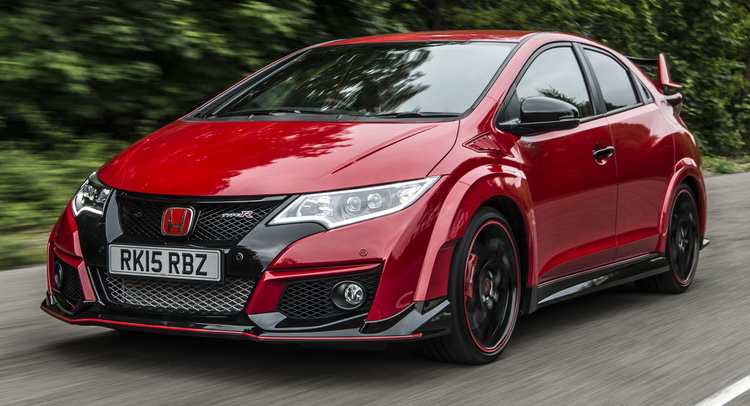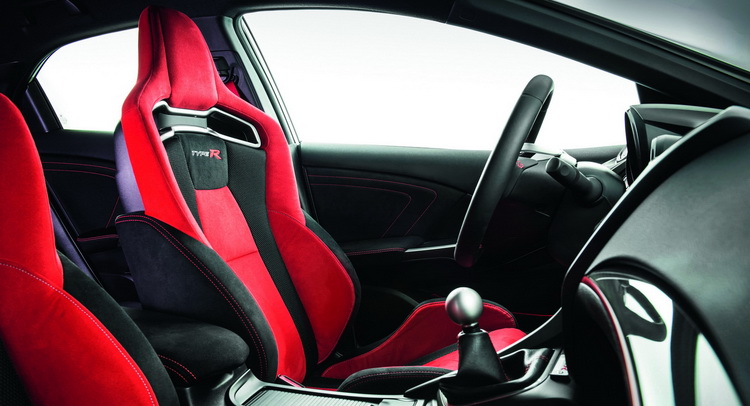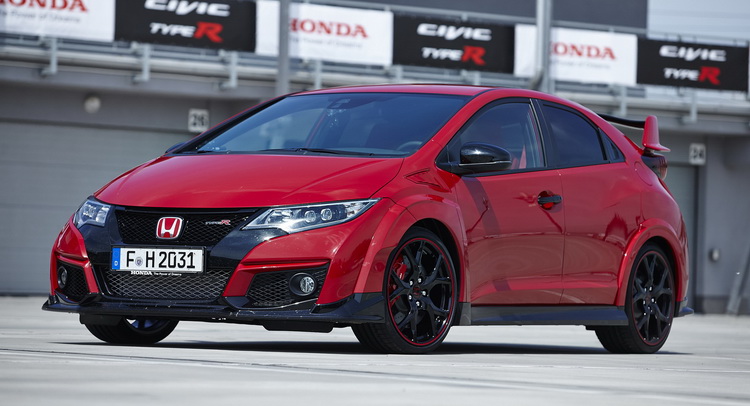And here I am, in Slovakia, face to face with Honda’s hottest hatch in years with its big wing peeping through the roof calling me to jump behind the wheel – challenge accepted Civic Type R, challenge accepted…
The new Civic Type R represents a big shift for Honda itself apart from the much-awaited return on a boiling-hot segment.
For the first time, Honda has thrown a turbocharger under a Type R’s bonnet, thanks to the ever-stricter emissions tests which practically showed the exit door to the dirty naturally aspirated screamers of the past.
The 2.0-litre engine is the first application of the combo which marries the infamous VTEC variable valve timing with a turbocharger and the outcome is 306hp (310PS) at 6500rpm and 295 lb ft of torque (400Nm) at 2500rpm. Zero to 62mph (0-100km/h) comes in 5.7 seconds while top speed is a rather impressive 167mph (269km/h).
Turbo Just Kicked In Yo
Keep your right foot buried and from around 2,000rpm it just picks up and goes, until it reaches the 5,500rpm mark where it founds a very familiar new surge towards the 7,000 rpm limiter. Honda has clearly made the most happy-to-rev turbocharged engine in the class, paying tribute to its glory past. There is also a serene smoothness in doing so for such a powerful FWD machine and no matter how hard I tried to push it into presenting some sort of annoying torque steer, the Civic Type R just wouldn’t succumb, much to my surprise. Even the Megane RS 275 Trophy’s steering kicks back at certain situations but unlike the French car, the Type R just remains uninfluenced in the most convincing way yet.
The front suspension utilizes Honda’s dual axis strut configuration which according to the company reduces torque steer by 55%. The rear suspension uses a torsion beam which is made by crashed pipes instead of a solid block and that increases the rear roll rigidity by a whopping 177%, removing the need for a rear anti roll bar. Torsional rigidity of the body shell has been increased by 18% by optimizing the bracket designs and applying adhesives instead of structural steel material, saving 4.5kg in the process.
A helical limited slip differential is tasked to split the power between the front wheels while the six-speed manual transmission -the only option- has a very short 40mm stroke, essentially matching the 2002 NSX-R which is considered to have one of the best manuals ever to exist.
Light and precise, the aluminum gear shifter is a treat as always, only now it’s better, and you catch yourself changing cogs faster and more effectively. Similarly the LSD keeps the front axle under control, providing immense grip and firm pulling of the nose during hard cornering.
Real Downforce
Many people expressed their concern about the wild looks of the new Civic Type R; the whole body hosts a rather huge aero agenda which hasn’t gained universal appraisal but Honda says that every single part of it has a functional purpose and that nothing is there for cosmetic reasons. The new Civic Type R features an almost completely flat underside which works actively with the big rear diffuser generating downforce as well as the front splitter, side skirts and of course that huge wing mounted on the back. The front bumper and wings are designed to reduce the turbulence around the front wheels for greater stability while all the air vents and grilles are fully functional, assisting in cooling the whole powertrain. And get this, Honda claims that the new Civic Type R is creating overall actual negative lift.
This isn’t a car to be taken lightly then, and you can sense that from the first few miles behind its wheel. The seat is gripping you tight, the ride is firm, the shifter is quick and the engine unleashes its torque with a satisfaction only a good turbo motor can offer, sneezing vividly with every opportunity. The only problem is the song it plays, which is just flat and the exhaust sound resonates a bit inside the cabin. 4-cylinder turbocharged engines are not known for their voices though and the whole sneezing is loud enough to help you in forgetting your troubles.
On the Road
The notorious +R button engages the most aggressive setting of the car, activating a sharper throttle map which offers more of the available torque at lower engine speeds, reducing the assistance of the electric power steering, stiffening the adaptive dampers by 30% and relaxing the Vehicle Stability Assist system, allowing bigger yaw and slip rates. Honda says that this is the optimal setting for attacking the Nurburgring. The two modes of the suspension are better described as firm and even firmer, with the latter probably being too harsh for use on the British B-roads but we have to wait until we drive it there to see how it copes.
Despite the general firmness, there is a new-found quality in the damping now which allows the car to manage bumps and other imperfections in a way that the previous generation simply couldn’t. The grip levels on offer are huge, and you feel the car forcing itself to bite harder, the faster you drive it. The precise steering has a nice weight to it and provides you with the feedback you need when driven hard, pulsing more once the front axle is reaching maximum grip levels. Combine this with a throttle response which allows you to finely tune your inputs with great precision and what you are left with is a very serious piece of weaponry indeed.
The car will eventually understeer but you have such precision on controlling its behavior with the throttle and the steering that you soon learn to ride on the limit of the front axle and just consume each corner with huge speeds and an even huger grin on your face. You can even invite the rear into play by lifting off the throttle or using the brakes, and the Type R will demonstrate an agile behavior than its predecessors could never even dreamed of. The only thing requiring some attention is in its slight tendency to follow the road’s camber but this sort of problems is a bit common with such an aggressive setup.
Bottom Line
With the new Civic Type R, I reckon Honda has pulled a great trick. You see, the Megane RS 275 Trophy is going to end its life cycle and rather soon, and then Honda will be the only one to offer a proper hardcore FWD burning-hot hatch. Is it better than the Megane RS 275 Trophy? A definitive answer can come only if both of them are driven back to back on the same road the same day.
This is actually one of the most capable and focused machines on the segment, with the sum of all its great parts working together to create a very exciting car, no matter what the price may be. This by the way starts at £29,995. If you can cope with the crazy BTCC looks of it, you are going to have an awesome time behind its wheel.
Special Info: A pre-production prototype lapped the Nurburgring in a record 7:50.63, almost four seconds faster than the previous holder, the Renault Megane RS 275 Trophy R, making the new Civic Type R the fastest FWD car around the iconic track. When asked about the differences between that roll caged prototype and the final product, Kotano Yamamoto, Honda’s R&D man said that the cage was there for safety reasons and that didn’t add any rigidity to the shell as it was bolted on the bushings. In any case, there was an implication that Honda might return to the Ring with a production car to verify their speed.





























































































































































































